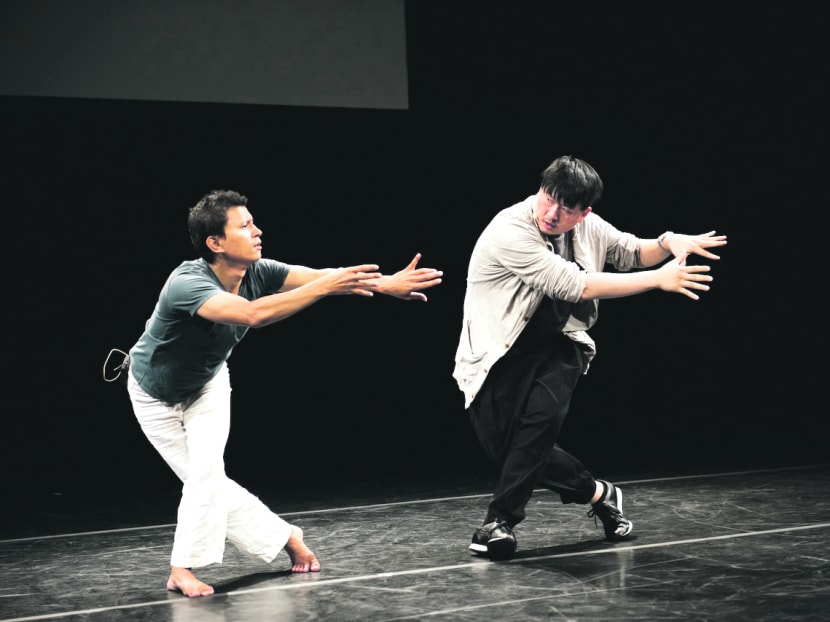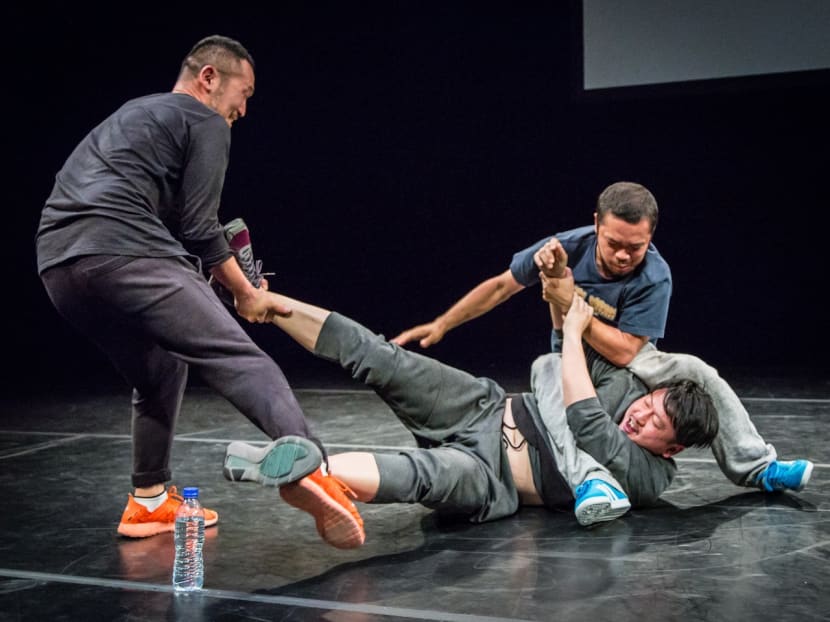da:ns fest 2015: SoftMachine pulls the plug on ‘Asian’ dance
SINGAPORE — Japanese group Contact Gonzo’s performances are kind of like dance-brawls between testosterone-pumped men, with lots of no-holds-barred punching and slapping, all of which emphasise their so-called “philosophy of pain”.


SINGAPORE — Japanese group Contact Gonzo’s performances are kind of like dance-brawls between testosterone-pumped men, with lots of no-holds-barred punching and slapping, all of which emphasise their so-called “philosophy of pain”.
And for interdisciplinary Singaporean artist Choy Ka Fai, the best way to understand an artist or to know a work is to dive right in, which, in this case, meant volunteering to get whacked and stepped on, pushed and punched, and turned into a human target for high-speed orange missiles.
At one point, as he is trapped in a knot of limbs underneath the group’s Yuya Tsukahara and Keigo Mikajiri, Choy continued to huff and puff: “I have a question...”
This hilarious but wince-worthy segment straight out of Jackass was part of Choy’s two-parter SoftMachine, a lecture performance featuring four Asian contemporary dance artists and groups from Japan, Indonesia, China and India.
With Asian contemporary dance being the international scene’s new frontier, examining and asking what makes the featured dancers tick seemed like an apt way to end da:ns festival’s 10th anniversary edition. Except that SoftMachine — which is part of a broader project that included a presentation at TheatreWorks and an exhibition at last year’s da:ns fest — challenged this catch-all, one-size-fits-all term.
Mixing video documentation and live performances, Choy offered up a two-in-one package of the “real deal” and behind-the-scenes stories that contextualised these artists and gave us a sense of “place”.
India’s Surjit Nongmeikapam and Indonesia’s Rianto’s performances, which comprised one show, highlighted issues of identity, embedded in the dance. Whether in geopolitical, gender or sexual terms, do not take things at face value, Choy reminded us.
Nongmeikapam, for instance, is from a part of India that’s near the border to Myanmar and has a completely different dance style from the so-called Indian dance — which he further complicated by asking, “North or south?”
In lecturer-talk show host mode, Choy requested his guest do a mash-up of his hometown’s dance — an “Indian” dance — and, to get the Europeans (and European fund-giving bodies) excited, “contemporary dance”.
There is a hint of a throwback to Victorian times with their specimen presentations and experimentation, and the tone here was nudge-wink mocking — there were digs at how Europe defines, perceives and funds the “Asian” in dance, and da:ns fest favourite Akram Khan, the UK-born kathak-trained superstar of Asian contemporary dance, was often in Choy’s cross hairs.
Meanwhile, Indonesian dancer Rianto presentation was as complicatedly layered as it could get: Entering as a graceful female dancer, the Javanese mask was taken off to reveal a man, who would later dance a male role. He then revealed he had a Japanese wife and lives in Japan to teach traditional Indonesian dance — while also performing contemporary dance and, on a personal note, going to saunas frequented by homosexual and bisexuals. “In contemporary dance, there is no man or woman,” he said.
The link between traditional and contemporary took a back seat in the second show, featuring the Contact Gonzo guys and Chinese wife-and-husband team Xiao Ke (a folk dancer-turned-contemporary dancer-turned-physical theatre practitioner) and Zi Han (a video and sound artist).
Here, Choy looked at other parameters that inform a dancer’s practice, whether it is politics or something else.
For the Chinese couple, it is the former. They presented an abstract, poetic piece involving a huge piece of red cloth and a vague dialogue about the process of making work. It is all in hints and all between the lines, but accompanying videos made clearer allusions to censorship and their outsider status in China.
And then, finally, there is Contact Gonzo with what seems like a brutally simple — and simply brutal — idea that they ran with. Contact improvisation, butoh and perhaps even parkour all blend into this long-term project — as Tsukahara prefers to call the group — that was born in the streets, in particular, a park in Osaka known to be frequented by gays. While all four pieces were obviously staged and rehearsed, there was a tingling sense of the unexpected, from the moment they started building a wooden contraption onstage and the first loud thuds of fist hitting chest echoed inside the Studio Theatre. It was entertainment in a masochist sense — as when everyone (including lighting designer Andy Lim) took turns being the target for a makeshift slingshot that launched oranges, with the requisite photos capturing the reactions. But at the same time, you couldn’t ignore the sharp insights Tsukahara, a non-dance-trained performer, had and the openness not seen in dance’s stratified world (a football tackle as a source of inspiration for dance?).
Throughout it all, Choy did the excellent balancing act of being there when he needs to be and being non-existent when he doesn’t. He gets teased on video by Xiao Ke as “the artist trying to lose weight”, gets bruised and battered by Contact Gonzo both live and in the video. In parts inquisitive reporter, invisible academic research, slapstick clown and heckling ringmaster, Choy put himself out there for an amazing project that insisted that we look closer at the rich complexity of dance in this part of the world right now.








